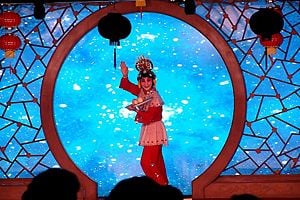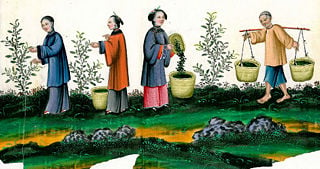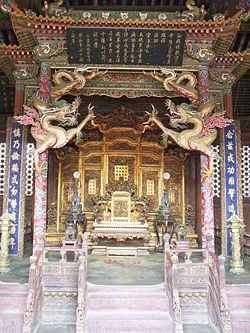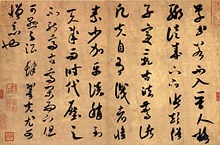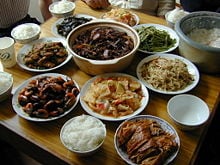Culture of China
The Culture of China (Chinese: šł≠ŚúčśĖáŚĆĖ) is home to one of the world's oldest and most complex civilizations covering a history of over 5,000 years. The nation covers a large geographical region with customs and traditions varying greatly between towns, cities and provinces. Chinese culture (Chinese: šł≠ŤŹĮśĖáŚĆĖ) is a broad term used to describe the cultural foundation, even among Chinese-speaking regions outside of mainland China.
Chinese culture underwent several turning points and renewals throughout its long unfolding but it was already rich and essential in the period of antiquity called the pre-Chin period that saw the brutal unification of China by Shi Huangdi. A major shift happened from the Shang dynasty which was still connected with barbarian practices to the Zhou dynasty when culture started to flourish.
The antique period saw the creation of language, the emergence of philosophy, science, and technology with a great intelligence and diversity that contrast with the chaos that plagued China during the Warring States period, particularly from the third century to the first century B.C.E.
The eight-third centuries were such an "axial" period as Karl Jaspers said that inventors and thinkers of later periods regularly came back to that period for inspiration. Many texts of that period called classics or "sacred books" have been endlessly commented until the modern times and remain always a source of wonder and discovery.
People in the culture
Identity
Many ethnic groups have existed in China. In terms of numbers, however, the preeminent ethnic group is the Han Chinese, Han tribe śľĘśóŹ or Han people śľĘšļļ. The term Han comes from the dynasty (206 B.C.E.-220 C.E.) which succeeded the Chin founded by Shi Huangdi, but it evokes the people who already in the ancient period, especially in the north-eastern part, took conscience of belonging to the same group and who made the cultural base for the whole country. On that base the Han were able to expand West and to assimilate other groups culturally.
Throughout history, many groups have been assimilated into neighboring ethnicities or disappeared without a trace. At the same time, many within the Han identity have maintained distinct linguistic and regional cultural traditions. The term Zhonghua Minzu has been used to describe the notion of Chinese nationalism in general. Much of the traditional cultural identity within the community has to do with distinguishing the family name.
It is to be noted that although foreign powers like the Mongols in 1260 and the Manchu in 1644 took over China, they had to unite with the Confucian and Neo-Confucian views and with the Chinese culture if they wanted to keep their power and really govern. Therefore, foreign leaders became very much sinocized and even sinophile. The Manchu Kangxi was extremely well versed in the Chinese classics and a great protector of the Confucian humanities.
Regional
Traditional Chinese Culture covers large geographical territories, each region being usually divided into distinct sub-cultures. Using modern names, here are some distinction:
- The Yellow River basin areas include Henan, Shanxi, Shanxi, Hebei, and Shandong
- The Yangtze River areas include Sichuan, Yunnan, Guizhou, Hunan, Hubei, Jiangxi, Anhui, Zhejiang, and Jiangsu.
Society
The dragon is such an important symbol in China that it deserves a few remarks. The dragon has been used in other cultures with different meanings. In Christianity, the dragon is related to the snake of the Fall and is called the Beast in the Book of Revelation with the meaning of evil and the enemy of man and God. Saint George is represented as defeating the dragon. However, in the Chinese culture the dragon is more related to the cosmic forces without the connotation of evil. The dragon in the first hexagram of the Book of Changes called "The Creative" represents the profound man who comes out of his hidden position and starts to act openly in a cautious way. While developing his action he must be careful not to fall into arrogance when reaching a high position. Richard Wilhelm, who translated first The Book of Changes into German, commented: "The dragon in China is a symbol of the electrically charged, dynamic, arousing force that manifests itself in the thunderstorm. In winter this energy withdraws into the earth; in the early summer it becomes active again … as a result the creative forces on earth begin to stir again."
Structure
Since the Three Sovereigns and Five Emperors period, some form of Chinese monarch has been the main ruler above all. Different periods of history have different names for the various positions within society. Conceptually each imperial or feudal period is similar, with the government and military officials ranking high in the hierarchy, and the rest of the population under regular Chinese law[1]
The Chinese take as models of leadership the semi-legendary emperors Yao and Shun who were called from among the poor people and lived a sacrificial self-less life before being asked to lead the empire. It is therefore considered as a regression to have accepted the transmission of power by the hereditary way.
The Zhou started the conception of the Mandate of Heaven Ś§©ŚĎĹ that they considered having received in order to stop the evil ruling of the Shang. Mencius developed a political conception based on the Mandate of Heaven stating that the ruler can lose his Mandate and that in that case he can be removed by the people. With Confucius and Mencius the aim of ruling is to establish a structure of goodness, "ren," šĽĀśĒŅ for the sake of people.
Ancient Chinese education also has a long history especially with the Imperial examination.
Emperor Wu (156-87 B.C.E.) of the Han dynasty created the first university of 50 students, the number reaching 30 000 in later Han. The curriculum relied much on the Confucian classics. Although it was a period of Buddhism and of flourishing of poetry the Tang dynasty (581-907) established a system of imperial examination in 605. This system was going to remain all throughout history with modifications at different subsequent periods. The examination to select future leaders of the country included two main parts, one on the Confucian classics, the other being an essay on political subjects and also on poetry. Candidates were also evaluated according to their appearance, ability in speech and calligraphy. The examination was open to all males differently from the previous dynasties, although the aristocrats had their way to succeed better.
Trades and crafts were usually taught by a sifu. The female historian Ban Zhao wrote the Lessons for Women in the han dynasty and outlined the four virtues women must abide to. Chinese marriage and Taoist sexual practices are some of the customs and rituals found in society.
Values
Most social values are derived from Confucianism and Taoism with a combination of conservatism. The subject of which school was the most influential is always debated as many concepts such as Neo-Confucianism, Buddhism and many others have come about. Reincarnation and other rebirth concept is a reminder of the connection between real-life and the next-life.
Early wisdom, Confucius's thought, and related thoughts of Mencius and Sunzi have played a major role in shaping the Chinese values until the introduction of Buddhism in the late Han first century C.E., Buddhism reaching its peak during the period of disunity from the third century to the ninth century.
Early Confucianism emphasized the deep cultivation of the Self and correction of the heart in order to serve others and be able to correctly establish a family and also to contribute to the shaping of a country in caring for people of all ages and particularly for those in need. The Confucian figures were the ruler as a parent to all and the parents of the family with the values of loyalty towards the sovereign and filial piety towards the parents.
This dramatically changed with the coming of Buddhism. Although both schools of thought share the values of heart, "ren" or compassion, care for others in the ideal way, the Buddhist figure is more the celibate monk or nun. The primary interest in Buddhism is not the family values or the elaboration of social institutions, but more a quest for self spiritual enlightenment and salvation. Therefore, from this period of the fourth to ninth centuries C.E. in China remained a tension that never really resolved between Confucianism and Buddhism.
This is one of the reason that Confucian scholars worked hard at creating a Confucian renaissance, called Neo-Confucianism, that went back to the ancient foundation and conveyed the core of Confucianism in a new more elaborated way philosophically and metaphysically.
Taoism brought a complementary aspect in the development of Chinese values and culture so much so that the three thoughts are inseparable. Taoism is very critical of all that is artificial and the fruit of abstract reasoning. It takes nature as a model and advocates the need to strive for naturalness, spontaneity, creativity and simplicity. When someone reaches the top of his art in working he does things naturally, without efforts or pretense. Taoists withdrew a bit too much of social responsibilities but their deep message was understood by the Confucians and the Buddhists.
Language
Spoken Chinese consisted of a number of Chinese dialects throughout history. In the Ming Dynasty, standard Mandarin was nationalized. Even so, it wasn't until the Republic of China era in the 1910s when there was any noticeable result in promoting a common unified language in China.
The ancient written standard was Classical Chinese. It was used for thousands of years, but was mostly reserved for scholars and intellectuals. By the twentieth century, millions of citizens, especially those outside of the imperial court were illiterate.[1] Only after the May 4th Movement did the push for Vernacular Chinese begin. This allowed common citizens to read since it was modeled after the linguistics and phonology of a spoken language.
Despite its difficulty to master, Classical Chinese remains extremely important in the world heritage of languages. Classical Chinese's birth is concomitant to the beginning of astronomy, the connection with higher spirits through divination and the formation of several Books of Changes, the most famous being the one of the Zhou dynasty. Therefore Chinese is not just a code or a tool, it is packed with profound meaning and wisdom that gives light and guidance to people in their decisions and actions when received in the proper way. Classical Chinese has been the cultural backbone of all the great philosophies, spiritualities, and even arts not just in China but all over Asia.
Mythology and spirituality
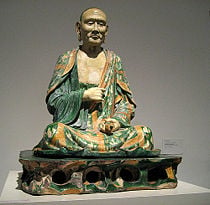
The Chinese never developed extensive myths such as those of Ancient Greece or Rome. They mentioned late in the South semi-divine figures like Pangu to explain the cosmic development of the world. But in general they were more interested in semi legendary figures having already an historical dimension and who were concerned by the development of human civilization like Fuxi and Shennong.
A large part of Chinese culture is based on the notion that a spiritual world exists. Countless methods of divination have helped answer questions, even serving as an alternate to medicine. Folklores have helped fill the gap for things that cannot be explained. There is often a blurred line between myth, religion and unexplained phenomenon. While many deities are part of the tradition, some of the most recognized holy figures include Guan Yin, Jade Emperor, and Budai. Other concepts have extended to outside of mythology into spiritual symbols such as Door god and the Imperial guardian lions. Along with the belief of the holy, there is also the evil. Practices such as Taoist exorcism fighting mogwai and jiang shi with peachwood swords are just some of the concepts passed down from generations. A few Chinese fortune telling rituals are still in use today after thousands of years of refinement.
Health
A large part of traditional Chinese culture is about finding the balance of Yin and Yang in relation to Qi, health, and the meridian system in order to find harmony. Traditional Chinese medicine consists of a number of treatments including Chinese herbology and acupuncture. Other less intrusive forms of health improvement include qigong and meditation.
The Chinese vision brings something essential in the understanding of man as a whole, of the body in order to prevent sickness and to take care when an unbalance takes place. This approach appeals to philosophy and wisdom. With the understanding of the Creative and the Receptive, the Yin and the Yang, the corresponding bestowing what is hidden and what is manifested, the harmony of the Tao and the myriads things benefiting of its working, we see how each being receives its nature and its potential of development and when following essential principles keeps an harmonious balance between the different dimensions of one's being. For example the body is healthy when keeping the balance between its different components and when energy and blood are smoothly circulating. The Chinese developed all kinds of techniques to nourish and balance the breath which is so vital to the duration of activities.
Confucius insisted in the Zhongyong on the cardinal dimension of the "Mean" šł≠, Middle, that is also present in Aristotle but in a less Ontological way. Confucius lamented that people usually missed this golden center because they were either excessive or lacking effort. Finding the center is to reach proper emotions, thoughts and decisions. It is to enter into harmony with the universe and others. Therefore because of our lack of true vision we often lead a life that is not fully healthy.
Literature
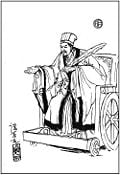
The extensive collection of books that have been preserved since the Zhou Dynasty demonstrate just how advanced the intellectuals have been at one time. The Five Cardinal Points is the foundation for almost all major studies. Concepts covered within the Chinese classic texts present a wide range of subjects including poetry, astrology, astronomy, calendar, constellations, and many others. Some of the most important early texts include I Ching and Shujing within the Four Books and Five Classics. Many Chinese concepts such as Yin and Yang, Qi, Four Pillars of Destiny in relation to heaven and earth were all theorized in the dynastic periods.
Notable Confucianists, taoists and scholars of all class have made significant contributions from documenting history to authoring saintly concepts that seem hundred of years ahead of time. Many novels such as Four Great Classical Novels spawned countless fictional stories. By the end of the Qing Dynasty, Chinese culture would embark on a new era with Vernacular Chinese for the common citizens. Hu Shih and Lu Xun would be pioneers in modern literature.
Arts
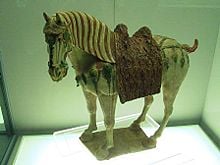
Different forms of art have swayed under the influence of great philosophers, teachers, religious figures and even political figures. Chinese art encompasses all facets of fine art, folk art and performance art. Porcelain pottery was one of the first form of art in the Palaeolithic period. Early Chinese music and poetry was influenced by the Book of Songs, Confucius and the Chinese poet and statesman Qu Yuan. Chinese painting became a highly appreciated art in court circles encompassing a wide variety of Shan shui with specialized styles such as Ming Dynasty painting. Early Chinese music was based on percussion instruments, which later gave away to string and reed instruments. By the Han dynasty paper cutting became a new art form after the invention of paper. Chinese opera would also be introduced and branched regionally in additional to other performance formats such as variety arts.
Martial arts
China is the original birth place of Eastern martial arts. The names of martial arts were called Kung Fu or its first name Wushu. China also includes the home to the well-respected Shaolin Monastery and Wudang Mountains. The first generation of art started more for the purpose of survival and warfare than art. Overtime, some art forms have branched off, while others have retained a distinct Chinese flavor. Regardless, China has brewed some of the most renowned martial artists including Wong Fei Hung and many others. The art have also co-existed with a variety of weapons including the more standard 18 arms. Legendary and controversial moves like Dim Mak are also praised and talked about within the culture.
Fashion
Different social class in different time eras boast different fashion trends. China's fashion history covers thousands of years with some of the most colorful and diverse arrangements. Fashionable but questionable practices such as footbinding have also been part of the culture. Many symbols such as phoenix have been used for decorative as well as political purposes.
Architecture
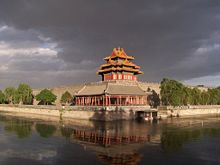
Chinese architecture, examples of which can be found from over 2,000 years ago, has long been a hallmark of the culture. There are certain features common to Chinese architecture, regardless of specific region or use. The most important is its emphasis on width, as the wide halls of the Forbidden City serve as an example. In contrast, western architecture emphasize on height, though there are exceptions such as pagodas.
Another important feature is symmetry, which connotes a sense of grandeur as it applies to everything from palaces to farmhouses. One notable exception is in the design of gardens, which tends to be as asymmetrical as possible. Like Chinese scroll paintings, the principle underlying the garden's composition is to create enduring flow, to let the patron wander and enjoy the garden without prescription, as in nature herself. Feng shui has played an important part in structural development.
Cuisine
The overwhelmingly large variety mainly comes from the emperors hosting a banquet of 100 dishes each meal[2] Countless number of imperial kitchen staff and concubines were involved in the food preparation process. Over time, many dishes became part of the everyday citizen culture. Some of the highest quality restaurants with recipes close to the dynastic periods include Fangshan restaurant in Beihai Park Beijing and the Oriole Pavilion[2]. Arguably all branches of Hong Kong eastern style or even American Chinese food are in some ways rooted from the original dynastic cuisines.
Leisure
A number of games and past-times are popular within Chinese culture. The most common game is Mah Jong. The same pieces are used for other styled games such as Shanghai Solitaire. Others include Pai Gow, Pai gow poker, and other bone domino games. Go proverb and Xiangqi is also popular. Ethnic games like Chinese yo-yo are also part of the culture.
See also
- Sinology
- Chinese Thought
- Traditional Chinese objects
- Science and technology in China
- Chinese astronomy
- Chinese calendar
- Chinese mathematics
- Chinese units of measurement
- Chinese measure word
Gallery
"Nine Dragons" handscroll section, by Chen Rong, 1244 C.E., Chinese Song Dynasty, Museum of Fine Arts, Boston.
Notes
- ‚ÜĎ 1.0 1.1 Boye De Mente, The Chinese Have a Word for it: The Complete Guide to Chinese Thought and Culture (McGraw-Hill Professional, 2000, ISBN 0658010786)
- ‚ÜĎ 2.0 2.1 Kong, Foong, Ling The Food of Asia (Tuttle Publishing, 2002, ISBN 0794601464).
ReferencesISBN links support NWE through referral fees
- Davis, Edward L. Encyclopedia of Contemporary Chinese Culture. London: Routledge, 2005. ISBN 978-0415241298
- De Bary, William Theodore, Irene Bloom, Wing-tsit Chan, Joseph Adler, and Richard John Lufrano. Sources of Chinese Tradition. New York: Columbia University Press, 1999. ISBN 978-0231109383
- East-West Philosophers' Conference, and Charles Alexander Moore. The Chinese Mind; Essentials of Chinese Philosophy and Culture. Honolulu: East-West Center Press, 1967. OCLC 252896
- Hucker, Charles O. China's Imperial Past: An Introduction to Chinese History and Culture. Stanford, Calif: Stanford University Press, 1975. ISBN 978-0804708876
- Latourette, Kenneth Scott. 1964. The Chinese, Their History and Culture. New York: Macmillan. OCLC 722633
- Yu, Dong, Zhong Fang, and Lin Xiaoling. Chinese Culture. Beijing: Foreign Language Press, 2004. ISBN 978-7119036151
External links
All links retrieved January 11, 2024.
| ||||||||
Credits
New World Encyclopedia writers and editors rewrote and completed the Wikipedia article in accordance with New World Encyclopedia standards. This article abides by terms of the Creative Commons CC-by-sa 3.0 License (CC-by-sa), which may be used and disseminated with proper attribution. Credit is due under the terms of this license that can reference both the New World Encyclopedia contributors and the selfless volunteer contributors of the Wikimedia Foundation. To cite this article click here for a list of acceptable citing formats.The history of earlier contributions by wikipedians is accessible to researchers here:
The history of this article since it was imported to New World Encyclopedia:
Note: Some restrictions may apply to use of individual images which are separately licensed.
